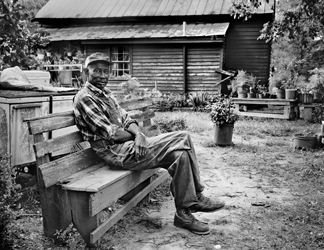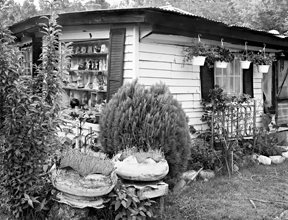Art Essay: African American Gardens and Yards
By Leigh Donaldson
ART TIMES online January 2015
 James Cox, Oglethorpe, Georgia, 1987 |
When the renowned African-American artist and art historian, David Driskell, graciously invited me to interview him at his summer house and studio in Falmouth, Maine, the first thing I noticed as I drove up his drive was a quarter acre of thriving corn, potatoes, tomatoes, beans, collard greens, okra and cucumbers, alongside brilliant beds of irises, begonias and zinnias. A Georgia native who grew up poor in the western Appalachian region of North Carolina, Driskell is as proud of his garden as he was of his acclaimed paintings. He even designed his house to be able to look up at the tall pines nearby. To him, the Maine pine that appears in many of his works is a symbol of eternity, of everlasting life.
“The wild spirit of unspoiled nature worked its way into the backwoods, an ancestral legacy, handed down from generation to generation”, writes bell hooks
in her essay “Earthbound: On Solid Ground”. An acclaimed African American author born in Kentucky hills “surrounded by a wilderness of honeysuckle, wild
asparagus and sheltering trees“, she learned to trust the soul of nature beyond words and that the ‘right‘ of nature trumps all humankind‘s. “To be fully
free, one had to embrace the organic rights of the earth…To tend to the earth is always then to tend our destiny, our freedom, and our hope”, she adds.
While driving along country roads through small towns and cities throughout the South during the late 1980s Vaughn Sills, a professor of photography at
Simmons College, was captivated by rural gardens she encountered and described them as giving her “…a sense of both order and mystery, with visual and
soul-satisfying contrast between open space and dense arrangements of plant life.” Sills subsequent photographic book, Places for the Spirit: Traditional African-American Gardens is a compilation of more than 80 fine art stills of African-American folk gardens and
their creators in Louisiana, Mississippi, Alabama, Georgia, South & North Carolina. The design and arrangement of these varied gardens, often appearing
casual, random and even whimsical, resonate with spiritual meaning and aesthetic significance centered on everyday life and the cycles of the natural
world. “There are no glittering prizes, like coverage in a fashion magazine, awaiting Vaughn Sills gardeners”, writes Hilton Als in the book’s foreword.
“Their reward is the freedom we and they find in their gardens.”
 Annie Bell Sturgehill, Athens, Georgia, 1988 |
Fully aware of her ‘outsider’ status, Sills gradually began to see these gardens as places of the spirit, where the gardeners provide ways of communicating
with ancestors, fending off harm and offer security to those entering. “In many of the gardens, I was drawn to the myriad objects placed to reflect light,
to create structure, to delight and entertain,” writes Sills in her introduction. “I soon learned, however, that all this beauty was far more than
entertainment, for beyond there was meaning of the greatest import…Objects have specific meanings that relate to magical powers or spirits of ancestors,
meanings that go back centuries and across an ocean.”
The gardens that Sills photographed and so many others, primarily found in the deep South are largely nurtured by an older, poorer generation of
African-Americans, who sustain a tradition that is being faded away by the ongoing assimilation of blacks into more urban, middle-class lifestyles. While
acknowledging the difficulty of generalizing about these garden arrangements, Lowry Pei, a professor of English at Simmons College, provides interesting
insights about their characteristics and what underlies the configurations of some of these distinctive landscapes in his introduction to Sills’ book.
They are not perfect and orderly in the manner that many European gardens were and still are. They are usually not maintained to be perpetually pristine.
However, Pei, whose sabbatical project was about our relationships with nature, suggests that these uniquely picturesque plots forever appear open to
re-arrangement. “Like life, the garden is not a perfectible product, but an ongoing process”, he writes. Yet, he adds that these gardens are not without
form or grace. Typically, they are in the front of the house and front porches, simultaneously establishing a private and public hiatus, often arranged for
socializing under the shade of trees; encouraging cookouts and neighborhood gatherings. Fences are rare, but there is frequently some semblance of a
boundary or threshold, such as a border of white colored rocks or shells. While inviting, these yards imply an expectation of harmonious behavior on the
part of the visitor.
Recurring elements include plants growing in containers, along with those in the ground, found objects of all sorts valued by the fact that they have been
used and now serve a different purpose, circles, pipes, stones, shells, as well objects that reflect or give off light, such as chrome, mirrors, tinfoil,
and wind ornaments such as chimes, pinwheels and fans. Many gardens feature figures and representations of living human beings, animals, and birds whose
presence, according to Pei, remind us that we are being seen as we observe.
 Leona Stokes’ Garden, Farrell, Mississippi, 2001 |
The predominance of the color white is apparently not arbitrary. For example, within the religious iconography of the Yoruba, an African tribal population
hard hit by attacks from slavers, the color white is associated with the sacred and good character, according to Pei. Among the Bakongo of the Central West
African coast, white was the color of the world of the dead, ancestors who command respect. Another noteworthy ceremonial tradition is the ‘bottle tree’,
whereby empty bottles of any color are placed over protruding tree branches and held up skyward. Bottle trees protect a home by trapping evil spirits,
which are believed to enter the inverted vessels where they cannot later escape. Circles, such as chrome car hubcaps (that also reflect light) and
whitewashed tires, are yet another constant visual theme in these gardens, representing the cycles of nature for the living and dead, as well as movement
or progress.
In many African cultures, the worlds of the living and dead are separated by water. Water is considered a pathway to the spirit world and the presence of
seashells decorating many of these gardens, as well as black gravesites and cemeteries, alludes to the ocean, the shell being a kind a carrier of the
immortal soul. The water metaphor is extended with the appearance of objects such as hand pumps, fountains, birdbaths, kettles, sinks, toilets and
bathtubs, often used as planters. Another African and African-American burial symbol appearing in gravesites and gardens are pipes stuck into the ground
created as a way of keeping communication lines open between the spirit and living world. Among the many striking black and white images in Sills book is
Herman Thompson’s tree-lined front yard in Jenkinsville, South Carolina. About six urns cleverly crafted from tires painted white are positioned in front
of the trees. With the surrounding area is woods, the effect is celestial. Thompson, a metal welder has also crafted fanciful figures of animals and
insects placed throughout the yard.
The roots of these gardens and landscapes are indeed deep, as they hark back to African heritage and folklore, and speak to horticultural adjustments made
by blacks during the post-slavery years of share-cropping and communal farming. They are not manicured or formal landscapes. While they might appear
haphazardly assembled to the casual observer, there lies profound symbolism throughout and beneath the surface, often reflecting life and death in the
everyday natural world.
 Westmacott African American Garden |
According to Grey Gundaker, a professor of anthropology and American studies at the College of William and Mary, people of African descent have used visual
and material objects to express their beliefs about the intersecting worlds of matter and spirit since their earliest arrival to North America. In the
book, No Space Hidden: The Spirit of African-American Yard Work, she and author Judith McWillie explore African-American devotional arts in homes
and domestic gardens and landscapes. Symbolic materials such the all-seeing eye of the diamond star, the reflective surfaces that represent divinity, and
the watcher figures depicting messengers of judgment and authority, are shown to be a frequent lexicon in African-American culture, as well as garden and
yard design. The authors note that the consistent aims of these creations are devotion to God, justice on earth, and community improvement. In his book, African-American Gardens & Yards in the Rural South, Richard Westmacott, originally from England and a professor of environmental design at
the University of Georgia, utilizes historical and ethnographic research methods to unveil the evolution, patterns and functions of African-American yards,
gardens, landscape architecture and material culture in the rural South. The work traces the development of African-American gardens over 200 years and the
possible origins of certain traditions such as the ‘swept yard’, considered a West African tradition brought to America by black slaves who often cooked
and washed outdoors in dirt yards because slave quarters were too constricted. They swept clean these yards with brooms made from branches, sometimes
dogwood, gathered from the woods. During slavery, white plantation owners also adopted the swept yard concept and these areas were usually kept up by
slaves or servants.
Before mass migration of American blacks to northern states during the early 1900s, more than 90% of all people of color lived and labored in an agrarian
South, making them true people of the earth. As the descendants of slaves who worked the land, many African-Americans have cultivated a unique kinship with
the earth, animals and vegetation.
“Recognition of the connectivity with worlds beyond the human is revealed as a necessity of spiritual and physical survival”, writes Camille T. Dungy,
editor of Black Nature: Four Centuries of African-American Nature Poetry. “Even during the most difficult periods of African-American history, the
natural world held potential to be a source of refuge, sustenance and un-compromised beauty.”
The memories I have of visiting my paternal grandmother’s house in Edwards, Mississippi during early childhood remain profound. The large clapboard house,
the warming wood stove, wild dandelions surrounding the front porch, the old oak tree branches swaying in the warm breeze, crows cackling in the cornfields
and days filled with the tranquil rhythms of natural rural life. Most importantly, I will always feel the psychic energy she derived from working in
communion with the earth and how this vitality transcended any spoken words.
Resources:
~Dungy, Camille T. Black Nature: Four Centuries of African-American Nature Poetry. University of Georgia Press, 2009.
~Glave, Dianne D. Rooted in the Earth: Reclaiming the African-American Environmental Heritage. Chicago Review Press, 2010.
~Gundaker, Grey. ed. Keep Your Head to the Sky: Interpreting African-American Home Ground. Charlottesville: University of Virginia Press, 1998.
~hooks, bell. “Earthbound: On Solid ground” in The Colors of Nature: Culture, Identity & the Natural World, ed. ~Alison H. Deming & Lauret
E. Savoy. Minneapolis: Milkweed Editions, 2002.
~Kane, Richard, producer/director. David Driskell: In Search of the Creative Truth. Maine Master Project/Union of Maine Visual Artists, 2012.
~McWille, Judith. No Space Hidden: The Spirit of African-American Yard Work. Knoxville: University of Tennessee Press, 2005.
~Raver, Anne. “In Georgia’s Swept Yards, a Dying Tradition”. The New York Times, 8 August 1993.
~Thompson, Robert Farris. Flash of the Spirit: African and African-American Art & Philosophy, New York: Vintage Books, 1984.
~Westmacott, Richard. African-American Gardens & Yards in the Rural South, Knoxville: University of Tennessee Press, 1992.
(Leigh Donaldson’s writing has appeared in print and online publications such as the The Montreal Review, Gastronomica: The Journal of Food & Culture, Sojourners Magazine, American Legacy Magazine, American Songwriter Magazine, Art Times Journal, Portland Monthly Magazine , Maine Food & Lifestyle Magazine, and “Maine’s Visible Black History” (Tilbury House Publishers). His book about the antebellum African-American Press in the Northeast will be published by McFarland & Co. Publishers in 2016.)
